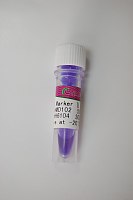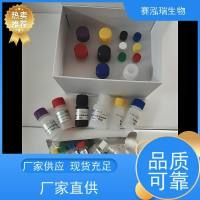Convenient and Efficient Approach to the Permanent or Reversible Conjugation of RNA and DNA Sequences with Functional Groups
互联网
- Abstract
- Table of Contents
- Materials
- Figures
- Literature Cited
Abstract
The conversion of 3?,5??disilylated 2??O ?(methylthiomethyl)ribonucleosides to 2??O ?(phthalimidooxymethyl)ribonucleosides is achieved in yields of 66% to 94%. Desilylation and dephtalimidation of these ribonucleosides by treatment with NH4 F in MeOH produce 2??O ?aminooxymethylated ribonucleosides, which are efficient in producing stable and yet reversible 2??conjugates upon reaction with 1?pyrenecarboxaldehyde. Exposure of 2??pyrenylated ribonucleosides to 0.5 M tetra?n ?butylammonium fluoride (TBAF) in THF or DMSO results in the cleavage of their iminoether functions to give the native ribonucleosides along with an innocuous nitrile side product. Conversely, the reaction of 2??O ?(aminooxymethyl)uridine with 5?cholesten?3?one leads to a permanent uridine 2??conjugate, which is left unreacted when treated with TBAF. The versatility and uniqueness of 2??O ?(aminooxymethyl)ribonucleosides is demonstrated by the single or double incorporation of a reversible pyrenylated uridine 2??conjugate into an RNA sequence. Furthermore, the conjugation of 2??O ?(aminooxymethyl)ribonucleosides with various aldehydes, including those generated from their acetals, is also presented. The preparation of 5??O ?(aminooxymethyl)thymidine is also achieved, albeit in modest yields, from the conversion of 5??O ?methylthiomethyl?3??O ?(levulinyl)thymidine to 5??O ?phthalimidooxymethyl?3??O ?(levuliny)lthymidine followed by hydrazinolysis of both 5??phthalimido and 3??levulinyl groups. Pyrenylation of the 5??O ?(aminooxymethyl)deoxyribonucleoside also provides a reversible 5??conjugate that is sensitive to TBAF, thereby further demonstrating the usefulness of 5??O ?(aminooxymethyl)deoxyribonucleosides for permanent or reversible modification of DNA sequences. Curr. Protoc. Nucleic Acid Chem. 50:4.52.1?4.52.36. © 2012 by John Wiley & Sons, Inc.
Keywords: 2??O?(aminooxymethyl)ribonucleosides; 5??O?(aminooxymethyl)deoxyribonucleosides; permanent or reversible conjugation; modification of DNA or RNA sequences; ribonucleoside 2??conjugates; deoxyribonucleoside 5??conjugates
Table of Contents
- Introduction
- Basic Protocol 1: Synthesis, Purification, and Characterization of 2′‐O‐(Aminooxymethyl)Ribonucleosides
- Alternate Protocol 1: Synthesis, Purification and Characterization of an Exemplary 5′‐O‐(Aminooxymethyl)Deoxyribonucleoside
- Basic Protocol 2: Synthesis, Purification, and Characterization of Ribonucleoside 2′‐Conjugates and of a Deoxyribonucleoside 5′‐Conjugate
- Support Protocol 1: Reversibility of Exemplary 2′‐O‐(Aminooxymethyl)Ribonucleoside Conjugates
- Basic Protocol 3: Synthesis, Purification, Characterization, and Reversibility of 2′‐Pyrenylated Chimeric RNA Sequences
- Alternate Protocol 2: Synthesis, Purification, Characterization, and Reversibility of a 5′‐Pyrenylated DNA Sequence
- Commentary
- Literature Cited
- Figures
Materials
Basic Protocol 1: Synthesis, Purification, and Characterization of 2′‐O‐(Aminooxymethyl)Ribonucleosides
Materials
Alternate Protocol 1: Synthesis, Purification and Characterization of an Exemplary 5′‐O‐(Aminooxymethyl)Deoxyribonucleoside
Basic Protocol 2: Synthesis, Purification, and Characterization of Ribonucleoside 2′‐Conjugates and of a Deoxyribonucleoside 5′‐Conjugate
Materials
Support Protocol 1: Reversibility of Exemplary 2′‐O‐(Aminooxymethyl)Ribonucleoside Conjugates
Materials
Basic Protocol 3: Synthesis, Purification, Characterization, and Reversibility of 2′‐Pyrenylated Chimeric RNA Sequences
Materials
Alternate Protocol 2: Synthesis, Purification, Characterization, and Reversibility of a 5′‐Pyrenylated DNA Sequence
|
Figures
-
Figure 4.52.1 Synthesis of 2′‐ O ‐(aminooxymethyl)ribonucleosides (S.5 a‐d ). Abbreviations: BP , a uracil‐1‐yl, b N 4 ‐benzoylctytosin‐1‐yl, c N 6 ‐isobutyryladenin‐9‐yl, d N 2 ‐phenoxyacetylguanin‐9‐yl; DBU, 1,8‐diazabicyclo[5.4.0]undec‐7‐ene; B, a uracil‐1‐yl, b cytosin‐1‐yl, c adenin‐9‐yl, d guanin‐9‐yl. Adapted from Cieślak et al. () by permission of Oxford University Press View Image -
Figure 4.52.2 Preparation of 5′‐ O ‐aminooxymethyl‐2′‐deoxythymidine (S.10 ). Abbreviations: Lev, levulinyl; Thy, thymin‐1‐yl; DBU, 1,8‐diazabicyclo[5.4.0]undec‐7‐ene. Adapted from Cieślak et al. () by permission of Oxford University Press View Image -
Figure 4.52.3 Synthesis of the pyrenylated ribonucleoside 2′‐conjugates S.11 a‐d and of the 5′‐pyrenylated 2′‐deoxythymidine conjugate S.12 . Abbreviations: B, a uracil‐1‐yl, b cytosin‐1‐yl, c adenin‐9‐yl, d guanin‐9‐yl; Thy, thymin‐1‐yl. Adapted from Cieślak et al. () by permission of Oxford University Press View Image -
Figure 4.52.4 Chemical structures of 2′‐ O ‐(aminooxymethyl)ribonucleoside conjugates derived from either acetals or an exemplary ketone. Abbreviations: Ura, uracil‐1‐yl; Cyt, cytosin‐1‐yl. Adapted from Cieślak et al. () by permission of Oxford University Press View Image -
Figure 4.52.5 RP‐HPLC analysis of the fluoride‐mediated conversion of silica gel–purified 2′‐ O ‐(pyren‐1‐ylmethanimine‐ N ‐oxymethyl)uridine (S.11 a ) to uridine. (A ) Chromatogram of the silica gel–purified S.11 a . (B ) Chromatogram of the conversion of S.11 a to uridine by treatment with 0.5 M TBAF in THF for 2 hr at 55°C. (C ) Chromatogram of mixed uridine and pyrene‐1‐carbonitrile commercial samples. Conditions: RP‐HPLC analysis is performed using UV detection (254 nm) and a 5‐µm Supelcosil LC‐18S column (25 cm × 4.6 mm) according to the following method: starting from 0.1 M triethylammonium acetate (pH 7.0), a linear gradient of 1% MeCN/min is pumped at a flow rate of 1 mL/min for 40 min; the gradient is then increased to 6% MeCN/min for 10 min at the same flow rate and kept isocratic for an additional 15 min. Peak heights are normalized to the highest peak, which is set to 1 arbitrary unit. Abbreviation: Ura, uracil‐1‐yl. Adapted from Cieślak et al. () by permission of Oxford University Press View Image -
Figure 4.52.6 RP‐HPLC analysis of the fluoride‐assisted conversion of silica gel–purified biotinylated uridine 2′‐conjugate S.16 to uridine. (A ) Chromatogram of silica gel–purified S.16 . (B ) Chromatogram of the conversion of S.16 to uridine by treatment with 0.5 M TBAF in THF for 6 hr at 55°C. (C ) Chromatogram of a commercial sample of uridine. Conditions: RP‐HPLC analysis is performed using UV detection (254 nm) and a 5 µm Supelcosil LC‐18S column (25 cm × 4.6 mm) according to the following method: starting from 0.1 M triethylammonium acetate pH 7.0, a linear gradient of 1% MeCN/min is pumped at a flow rate of 1 mL/min for 40 min. Abbreviation: Ura, uracil‐1‐yl. Adapted from Cieślak et al. () by permission of Oxford University Press View Image -
Figure 4.52.7 RP‐HPLC analysis of the fluoride‐mediated conversion of silica gel–purified dansylated uridine 2′‐conjugate S.18 to uridine. (A ) Chromatogram of silica gel–purified S.18 . (B ) Chromatogram of the conversion of S.18 to uridine by treatment with 0.5 M TBAF in THF for 24 hr at 55°C. (C ) Chromatogram of a commercial sample of uridine. RP‐HPLC analysis is performed under conditions identical to those described for the fluoride‐assisted conversion of S.11 a to uridine in Figure . Abbreviation: Ura, uracil‐1‐yl. Adapted from Cieślak et al. () by permission of Oxford University Press View Image -
Figure 4.52.8 RP‐HPLC analysis of the fluoride‐assisted conversion of silica gel–purified dansylated uridine 2′‐conjugate S.20 to uridine. (A ) Chromatogram of the silica gel–purified S.20 . (B ) Chromatogram of the conversion of S.20 to uridine by treatment with 0.5 M TBAF in THF for 48 hr at 55°C. (C ) Chromatogram of a commercial sample of uridine co‐mixed with an analytical sample of N ‐(4‐cyanobut‐1‐yl)‐5‐(dimethylamino)naphthalene‐1‐sulfonamide. Conditions: RP‐HPLC analysis is performed under conditions identical to those described for the fluoride‐assisted conversion of S.11 a to uridine in Figure . Abbreviation: Ura, uracil‐1‐yl. Adapted from Cieślak et al. () by permission of Oxford University Press View Image -
Figure 4.52.9 RP‐HPLC analysis of the fluoride‐assisted conversion of silica gel–purified dabsylated cytidine 2′‐conjugate S.22 to cytidine. (A ) Chromatogram of the silica gel–purified S.22 . (B ) Chromatogram of the conversion of S.22 to cytidine by treatment with 0.5 M TBAF in THF for 24 hr at 55°C. (C ) Chromatogram of a commercial sample of cytidine. Conditions: RP‐HPLC analysis is performed under conditions identical to those described for the fluoride‐assisted conversion of S.11 a to uridine in Figure . Abbreviation: Cyt, cytosin‐1‐yl. Adapted from Cieślak et al. () by permission of Oxford University Press View Image -
Figure 4.52.10 Synthesis of 5′‐ O ‐(4,4′‐dimethoxytrityl)‐2′‐ O ‐(pyren‐1‐ylmethanimine‐ N ‐oxymethyl)uridine (S.23 ) from 2′‐ O ‐(pyren‐1‐ylmethanimine‐ N ‐oxymethyl)uridine (S.11 a ) and conversion of S.23 to its 3′‐ O ‐phosphoramidite derivative S.24 . Abbreviations: DMTr, 4,4′‐dimethoxytrityl; Ura, uracil‐1‐yl. Adapted from Cieślak et al. () by permission of Oxford University Press View Image -
Figure 4.52.11 RP‐HPLC analysis of purified and desalted 5′‐r(undefinedAUCCGUAGCUAACGUCAUG)dT (S.25 ) and of its conversion to 5′‐r(UAUCCGUAGCUAACGUCAUG)dT (S.27 ) [undefined and dT represent 2′‐ O ‐(pyren‐1‐ylmethanimine‐ N ‐oxymethyl)uridine and 2′‐deoxythymidine residues, respectively]. (A ) Chromatogram of RP‐HPLC‐purified and desalted S.25 . (B ) Chromatogram of RP‐HPLC‐purified and desalted S.27 . (C ) Chromatogram of RP‐HPLC‐purified and desalted S.25 that was treated with 0.5 M TBAF in DMSO for 2 hr at 55°C and then desalted. RP‐HPLC analyses are performed using UV detection (254 nm) and a 5 µm Supelcosil LC‐18S column (25 cm × 4.6 mm) according to the following conditions: starting from 0.1 M triethylammonium acetate pH 7.0, a linear gradient of 1% MeCN/min is pumped at a flow rate of 1 mL/min for 40 min and is then held, isocratically, for 20 min. Peak heights are normalized to the highest peak, which is set to 1 arbitrary unit. Adapted from Cieślak et al. () by permission of Oxford University Press View Image -
Figure 4.52.12 RP‐HPLC analysis of purified and desalted 5′‐r(undefinedAUCCGUAGCundefinedAACGUCAUG)dT (S.26 ) and of its conversion to 5′‐r(UAUCCGUAGCUAACGUCAUG)dT (S.27 ) [undefined and dT represent 2′‐ O ‐(pyren‐1‐ylmethanimine‐ N ‐oxymethyl)uridine and 2′‐deoxythymidine residues, respectively]. (A ) Chromatogram of RP‐HPLC‐purified and desalted S.26 . (B ) Chromatogram of RP‐HPLC‐purified and desalted S.27 . (C ) Chromatogram of RP‐HPLC‐purified and desalted S.26 that was treated with 0.5 M TBAF in DMSO for 2 hr at 55°C and then desalted. RP‐HPLC analyses are performed as described in the caption of Figure . Adapted from Cieślak et al. () by permission of Oxford University Press View Image -
Figure 4.52.13 Synthesis of 5′‐ O ‐(pyren‐1‐ylmethanimine‐ N ‐oxymethyl)‐3′‐ O ‐[( N,N ‐diisopropylamino) (2‐cyanoethyloxy)]phosphinyl‐2′‐deoxythymidine (S.28 ) from 5′‐ O ‐(pyren‐1‐ylmethanimine‐ N ‐oxymethyl)‐2′‐deoxythymidine (S.12 ). Abbreviation: Thy, thymin‐1‐yl. Adapted from Cieślak et al. () by permission of Oxford University Press View Image -
Figure 4.52.14 RP‐HPLC analysis of purified and desalted 5′‐d(undefinedATCCGTAGCTAACGTCATGT) (S.29 ) and of its conversion to 5′‐d(TATCCGTAGCTAACGTCATGT) (S.30 ) [undefined corresponds to 5′‐ O ‐(pyren‐1‐ylmethanimine‐ N ‐oxymethyl)‐2′‐deoxythymidine]. (A ) Chromatogram of RP‐HPLC‐purified and desalted S.29 . (B ) Chromatogram of RP‐HPLC‐purified and desalted S.30 . (C ) Chromatogram of RP‐HPLC‐purified and desalted S.29 that was treated with 0.5 M TBAF in DMSO for 1 hr at 55°C and then desalted. RP‐HPLC analyses are performed as described in the caption of Figure . Adapted from Cieślak et al. () by permission of Oxford University Press View Image -
Figure 4.52.15 Fluoride‐assisted conversion of 2′‐ O ‐pyrenylated ribonucleosides (S.11 a‐d ) to native ribonucleosides. Abbreviations: TBAF, tetra‐ n ‐butylammonium fluoride; B, uracil‐1‐yl, cytosin‐1‐yl, adenin‐9‐yl, or guanin‐9‐yl. Adapted from Cieślak et al. () by permission of Oxford University Press View Image
Videos
Literature Cited
| Literature Cited | |
| Beaucage, S.L. 1999. Attachment of reporter and conjugate groups to DNA. In Comprehensive Natural Products Chemistry: DNA and Aspect of Molecular Biology, Vol. 7 (D. Barton, H. Nakanishi, O. Meth‐Cohn, E.T. Kool, eds.) pp. 153‐249. Elsevier, Oxford, United Kingdom. | |
| Beaucage, S.L. 2008. Solid‐phase synthesis of siRNA oligonucleotides. Curr. Opin. Drug Disc. Devel. 11:203‐216. | |
| Cieślak, J., Grajkowski, A., Ausín, C., Gapeev, A., and Beaucage, S.L. 2012. Permanent or reversible conjugation of 2′‐O‐ or 5′‐O‐aminooxymethylated nucleosides with functional groups as a convenient and efficient approach to the modification of RNA and DNA sequences. Nucleic Acids Res. 40:2312‐2329. | |
| Clark, J.H. 1980. Fluoride ion as a base in organic synthesis. Chem. Rev. 80:429‐452. | |
| Cook, P.D. 1998. Second generation antisense oligonucleotides: 2′‐Modifications. In Annual Report in Medicinal Chemistry, Vol. 33 (J.A. Bristol, ed.) pp. 313‐325. Academic Press, San Diego, California. | |
| Defrancq, E. and Lhomme, J. 2001. Use of an aminooxy linker for the functionalization of oligodeoxyribonucleotides. Bioorg. Med. Chem. Lett. 11:931‐933. | |
| Fang, S. and Bergstrom, D.E. 2003a. Reversible biotinylation phosphoramidite for 5′‐end‐labeling, phosphorylation, and affinity purification of synthetic oligonucleotides. Bioconjug. Chem. 14:80‐85. | |
| Fang, S. and Bergstrom, D.E. 2003b. Fluoride‐cleavable biotinylation phosphoramidite for 5′‐end‐labeling and affinity purification of synthetic oligonucleotides. Nucleic Acids Res. 31:708‐715. | |
| Fang, S. and Bergstrom, D.E. 2004. Reversible 5′‐end biotinylation and affinity purification of synthetic RNA. Tetrahedron Lett. 45:7987‐7990. | |
| Fang, S. and Fueangfung, S. 2010. Scalable synthetic oligodeoxynucleotide purification with use of a catching by polymerization, washing, and releasing approach. Org. Lett. 12:3720‐3723. | |
| Forget, D., Boturyn, D., Defrancq, E., Lhomme, J., and Dumy, P. 2001a. Highly efficient synthesis of peptide—oligonucleotide conjugates: Chemoselective oxime and thiazolidine formation. Chem. Eur. J. 7:3976‐3984. | |
| Forget, D., Renaudet, O., Defrancq, E., and Dumy, P. 2001b. Efficient preparation of carbohydrate–oligonucleotide conjugates (COCs) using oxime bond formation. Tetrahedron Lett. 42:7829‐7832. | |
| Forget, D., Renaudet, O., Boturyn, D., Defrancq, E., and Dumy, P. 2001c. 3′‐Oligonucleotides conjugation via chemoselective oxime bond formation. Tetrahedron Lett. 42:9171‐9174. | |
| Griffey, R., Lesnik, E., Freier, S., Sanghvi, Y.S., Teng, K., Kawasaki, A., Guinosso, C., Wheeler, P., Mohan, V., and Cook, P.D. 1994. New twists on nucleic acids structural properties of modified nucleosides incorporated into oligonucleotides. In Carbohydrate Modifications in Antisense Research (Y.S. Sanghvi and P.D. Cook, eds.) pp. 212‐224. American Chemical Society, Washington, D.C. | |
| Hilvert, D. 1994. Chemical synthesis of proteins. Chem. Biol. 1:201‐203. | |
| Katajisto, J., Virta, P., and Lönnberg, H. 2004. Solid‐phase synthesis of multiantennary oligonucleotide glycoconjugates utilizing on‐support oximation. Bioconjug. Chem. 15:890‐896. | |
| Kawasaki, A.M., Casper, M.D., Prakash, T.P., Manalili, S., Sasmor, H., Manoharan, M., and Cook, P.D. 1999. Synthesis, hybridization, and nuclease resistance properties of 2′‐O‐aminooxyethyl (2′‐O‐AOE) modified oligonucleotides. Tetrahedron Lett. 40:661‐664. | |
| Landini, D., Maia, A., and Rampoldi, A. 1989. Dramatic effect of the specific solvation on the reactivity of quaternary ammonium fluorides and poly(hydrogen fluorides), (HF)n• F− in media of low polarity. J.Org. Chem. 54:328‐332. | |
| Manoharan, M. 1999. 2′‐Carbohydrate modifications in antisense oligonucleotide therapy: Importance of conformation, configuration and conjugation. Biochim. Biophys. Acta 1489:117‐130. | |
| Morvan, F., Sanghvi, Y.S., Perbost, M., Vasseur, J.‐J., and Bellon, L. 1996. Oligonucleotide mimics for antisense therapeutics: Solution phase and automated solid‐support synthesis of MMI linked oligomers. J. Am. Chem. Soc. 118:255‐256. | |
| Parey, N., Baraguey, C., Vasseur, J.‐J., and Debart, F. 2006. First evaluation of acyloxymethyl or acylthiomethyl groups as biolabile 2′‐O‐protection of RNA. Org. Lett. 8:3869‐3872. | |
| Rastogi, H. and Usher, D.A. 1995. A new 2′‐hydroxyl protecting group for the automated synthesis of oligoribonucleotides. Nucleic Acids Res. 23:4872‐4877. | |
| Rodriguez, E.C., Winans, K.A., King, D.S. and Bertozzi, C.R. 1997. A strategy for the chemoselective synthesis of O‐linked glycopeptides with native sugar‐peptide linkages. J. Am. Chem. Soc. 119:9905‐9906. | |
| Rose, K. 1994. Facile synthesis of homogeneous artificial proteins. J. Am. Chem. Soc. 116:30‐33. | |
| Rozners, E. 2006. Carbohydrate chemistry for RNA interference: Synthesis and properties of RNA analogues modified in sugar‐phosphate backbone. Curr. Org. Chem. 10:675‐692. | |
| Salo, H., Virta, P., Hakala, H., Prakash, T.P., Kawasaki, A.M., Manoharan, M., and Lönnberg, H. 1999. Aminooxy functionalized oligonucleotides: Preparation, on‐support derivatization, and postsynthetic attachment to polymer support. Bioconjug. Chem. 10:815‐823. | |
| Semenyuk, A., Földesi, A., Johansson, T., Estmer‐Nilsson, C., Blomgren, P., Brännvall, M., Kirsebom, L.A., and Kwiatkowski, M. 2006. Synthesis of RNA using 2′‐O‐DTM protection. J. Am. Chem. Soc. 128:12356‐12357. | |
| Silverman, S.K. and Cech, T.R. 1999. RNA tertiary folding monitored by fluorescence of covalently attached pyrene. Biochemistry 38:14224‐14237. | |
| Sun, J., Dong, Y., Cao, L., Wang, X., Wang, S., and Hu, Y. 2004. Highly efficient chemoselective deprotection of O,O‐acetals and O,O‐ketals catalyzed by molecular iodine in acetone. J. Org. Chem. 69:8932‐8934. | |
| Trevisiol, E., Renard, A., Defrancq, E., and Lhomme, J. 1997. The oxyamino‐aldehyde coupling reaction: An efficient method for the derivatization of oligonucleotides. Tetrahedron Lett. 38:8687‐8690. | |
| Ti, G.S, Gaffney, B.L., and Jones, R.A. 1982. Transient protection: Efficient one‐flask syntheses of protected deoxynucleosides. J. Am. Chem. Soc. 104:1316‐1319. | |
| Tomaya, K., Takahashi, M., Minakawa, N., and Matsuda, A. 2010. Convenient RNA synthesis using a phosphoramidite possessing a biotinylated photocleavable group. Org. Lett. 12:3836‐3839. | |
| Watts, J.K., Deleavey, G.F., and Damha, M.J. 2008. Chemically modified siRNA: Tools and applications. Drug Disc. Today 13:842‐855. |









